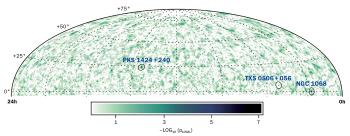
The sixth edition of Prospects in Neutrino Physics (NuPhys19) attracted almost 100 participants to the Cavendish Conference Centre in London from 16 to 18 December. Jointly organised by King’s College London and the Institute for Particle Physics Phenomenology at Durham University, the conference provides a much-needed snapshot of the fast-moving field of neutrino physics.
The neutrino community’s current challenge is to understand the origin of neutrino masses and lepton mixing. This means establishing whether neutrinos are Dirac or Majorana fermions, their absolute mass scale, the order of the measured mass splittings (the neutrino mass ordering), whether there is leptonic CP violation, the precise value of other parameters in the neutrino mixing matrix, and, finally, whether there is an indication of physics beyond the standard three-neutrino paradigm, for example through the detection of sterile neutrinos.
Construction of the Hyper-Kamiokande experiment will begin in 2020
2015 Nobel laureate Takaaki Kajita (University of Tokyo) opened the conference by confirming that construction of the Hyper-Kamiokande experiment will begin in 2020, following the allocation by the Japanese government of a supplementary budget on 13 December. Hyper-Kamiokande will be a water-Cherenkov detector with a total mass of 260 kton — almost an order of magnitude larger than its famous predecessor Super-Kamiokande, where atmospheric neutrino oscillations were discovered, and far larger than KamiokaNDE, which observed solar neutrinos and supernova SN1987A. Hyper-Kamiokande will eventually replace Super-Kamiokande as the far detector for the upgraded J-PARC neutrino beam, which is situated on the far side of Japan (essentially a comprehensive upgrade of the T2K experiment), with the aim of measuring CP violation in the leptonic sector. It will also provide high statistics for proton-decay searches, supernova neutrino bursts, atmospheric and solar neutrinos, and indirect searches for dark matter. Hyper-Kamiokande will therefore soon join DUNE in the US as a next-generation long-baseline neutrino-oscillation experiment under construction. Together the detectors will provide a far wider coverage of physics signals than either could manage alone.
Critical mass
News of KATRIN’s record-breaking new upper limit on the electron-antineutrino mass was complemented by a report by Joseph Formaggio (MIT) on the successful “Project 8” demonstration in the US of a new approach to directly measuring neutrino masses wherein the energies of beta-decay electrons are determined from the frequency of cyclotron radiation as the electrons spiral in a magnetic field. This work will be complemented by the JUNO experiment in China which will in 2021 begin to constrain the ordering of the neutrino-mass eigenvalues.
The search for neutrinoless double-beta decay also has the potential to provide information on neutrino masses. A potentially unambiguous indication of lepton-number violation and the postulated Majorana nature of neutrinos, it is being pursued aggressively as experiments compete to reduce backgrounds and increase detector masses to the ton-scale. Several talks emphasised the complementary progress by the theory community to better estimate nuclear effects, and reduce the errors arising from the differences between different nuclear models and different isotopes. These calculations are equally important for NOvA and T2K, which is now beginning to probe leptonic CP conservation at the 3? level.
The cosmological upper limit on the sum of neutrino masses could be relaxed upwards
Current and future cosmological constraints of neutrino properties were reviewed by Eleonora Di Valentino (Manchester), whose recent work with Alessandro Melchiorri and Joe Silk reinterprets Planck-satellite data to favour a closed universe at more than 99% significance – an inference which could lead to the current cosmological upper limit on the sum of neutrino masses being relaxed upwards if it is accepted by the community. Conversely, astrophysical neutrinos are also powerful tools for studying astrophysical objects. One key development in this field is the doping of Super-Kamiokande with gadolinium, currently underway in Japan. This will soon give the detector sensitivity to the diffuse supernova-neutrino background.
The next edition of NuPhys will take place in London from 16 to 18 December 2020.








